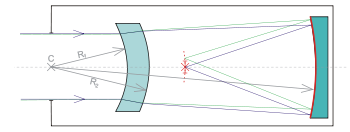- Albert Bouwers
-
Albert A. Bouwers (1893–1972) was a Dutch optical engineer.[1] He is known for developing and working with X-Rays and various optical technologies as a high-level researcher at Philips research labs. He is lesser known for patenting in 1941 a catadioptric meniscus telescope design similar to but slightly predating the Maksutov telescope.[2][3]
Contents
Biography
Bouwers was born in the town of Dalen in the Netherlands in 1893.[4] He obtained his Ph.D. from Utrecht University in 1924, with a dissertation entitled in Dutch Over het meten der intensiteit van Röntgenstralen[5] He was also the director of the Philips Laboratory's X-Ray Department.[6]
Bouwers developed a night vision device for viewing in low light conditions, called the "night eye".[7] The design used a photosensitive layer of cesium and antimony in a cathode-ray tube, to brighten images by over 1,000 times.[7] Unlike active infrared systems, it did not require an infrared flashlight.[7] The design was initially produced by Olde Delft Optical Company in the Netherlands.[7]
Bouwers meniscus telescope
In August 1940[8] Albert Bouwers built a prototype for a design for a wide field concentric meniscus telescope[8] (patented February 1941) similar to, and slightly predating, Russian optician Dmitri Dmitrievich Maksutov's 1941 Maksutov telescope.[2][3] War time secrecy kept Bouwers and Maksutov from knowing about each others designs[9] and Bouwers’ design was not published until after World War II.[10] Bouwers original design (based on an earlier catadioptric telescope, Bernhard Schmidt's "Schmidt camera")[2] had the spherical mirror and spherical "meniscus corrector shell" all with a common radius of curvature (a concentric or monocentric design). Like the Schmidt camera, the meniscus telescope has the aperture stop coincide with the center of curvature. It also shares the Schmidt's curved image plane. The design has an ultra wide field of view with no spherical aberration but does not correct chromatic aberration and was only suitable as a monochromatic astronomical astrographic camera working at a single wavelength of light.[1][2] Bouwers came up with a later design that used a cemented doublet to form the meniscus corrector shell to correct chromatic aberration.[11]
References
- ^ a b Ian Ridpath, "Bouwers telescope", A Dictionary of Astronomy, 1997 first sentence of article
- ^ a b c d Evolution of the Maksutov design
- ^ a b Reflecting Telescope Optics: Basic design theory and its historical development, By Ray N. Wilson page 150
- ^ Reflecting Telescope Optics, by Ray N. Wilson, page 498. Google Books, pg 498
- ^ Mathematics Genealogy Project "Albert Bouwers"
- ^ "Tensions within an Industrial Research Laboratory: The Philips Laboratory's X-Ray Department between the Wars", by Kees Boersma, Vrije Universiteit Amsterdam. Boersma Enterprise Soc. 2003; 4: 65-98 Oxford Journals abstract
- ^ a b c d "The View in the Dark", Time Magazine; Friday, Jun. 21, 1963 article
- ^ a b The History of the Telescope By Henry C. King, page 360; google books
- ^ Dmitri Maksutov: The Man and His Telescopes By Eduard Trigubov and Yuri Petrunin
- ^ Armstrong, E. B., "Geometrical Optics and the Schmidt Camera", Irish Astronomical Journal, vol. 1(2), p. 48
- ^ D. J. Schroeder, "Astronomical Optics", page 202
Further reading
Categories:- 1893 births
- 1972 deaths
- People from Coevorden
- Opticians
- Utrecht University alumni
- Optical engineers
Wikimedia Foundation. 2010.

